Land Law and Property Rights
VerifiedAdded on 2020/06/06
|9
|2817
|55
AI Summary
This assignment delves into the intricacies of UK land law, covering topics such as the Law of Property Act 1925, joint tenancy, trusts, and relevant case law. It examines how property rights are established, transferred, and protected under English legal frameworks. The content draws upon seminal cases like Jones v Kernott and explores practical applications through examples like Declaration of Trust form TR1.
Contribute Materials
Your contribution can guide someone’s learning journey. Share your
documents today.
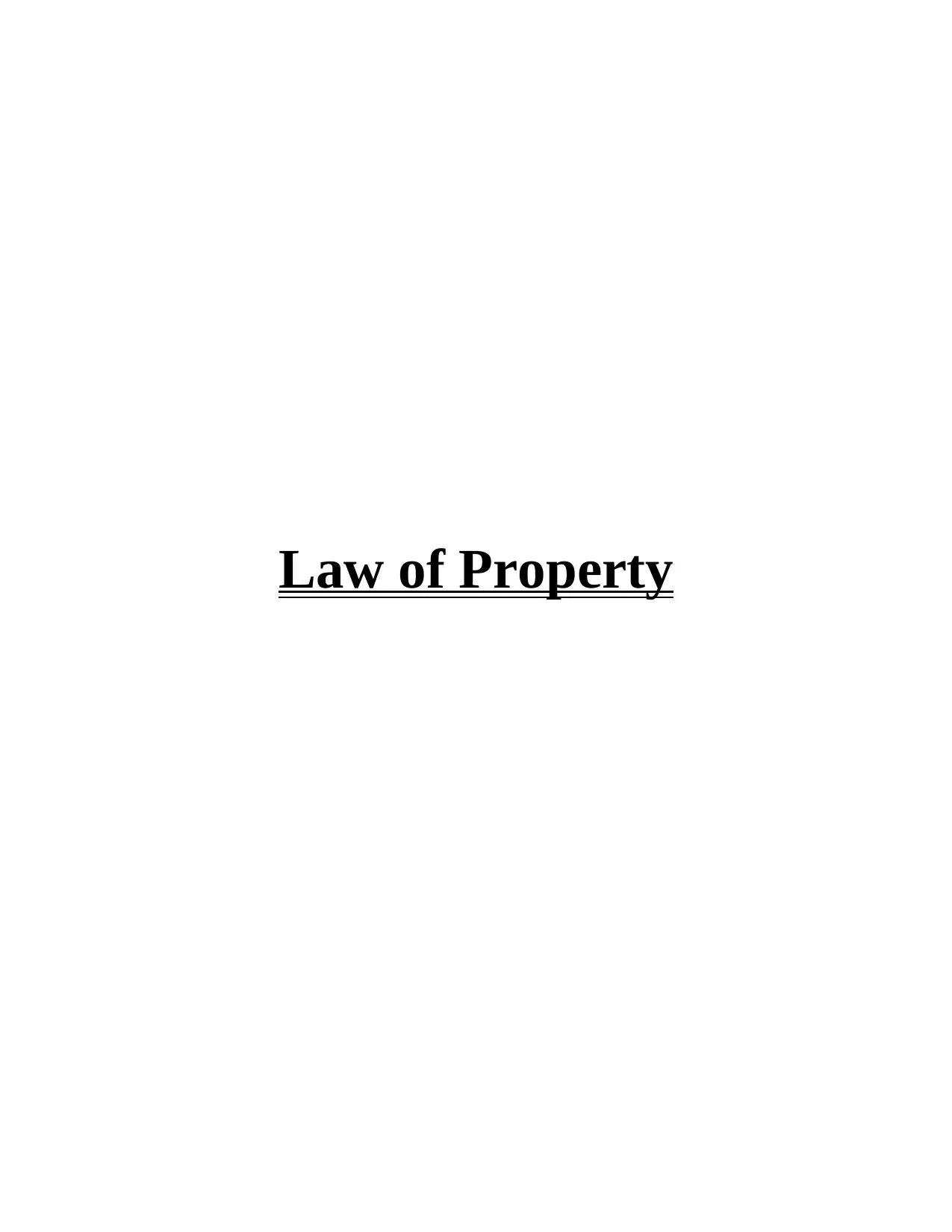
Law of Property
Secure Best Marks with AI Grader
Need help grading? Try our AI Grader for instant feedback on your assignments.
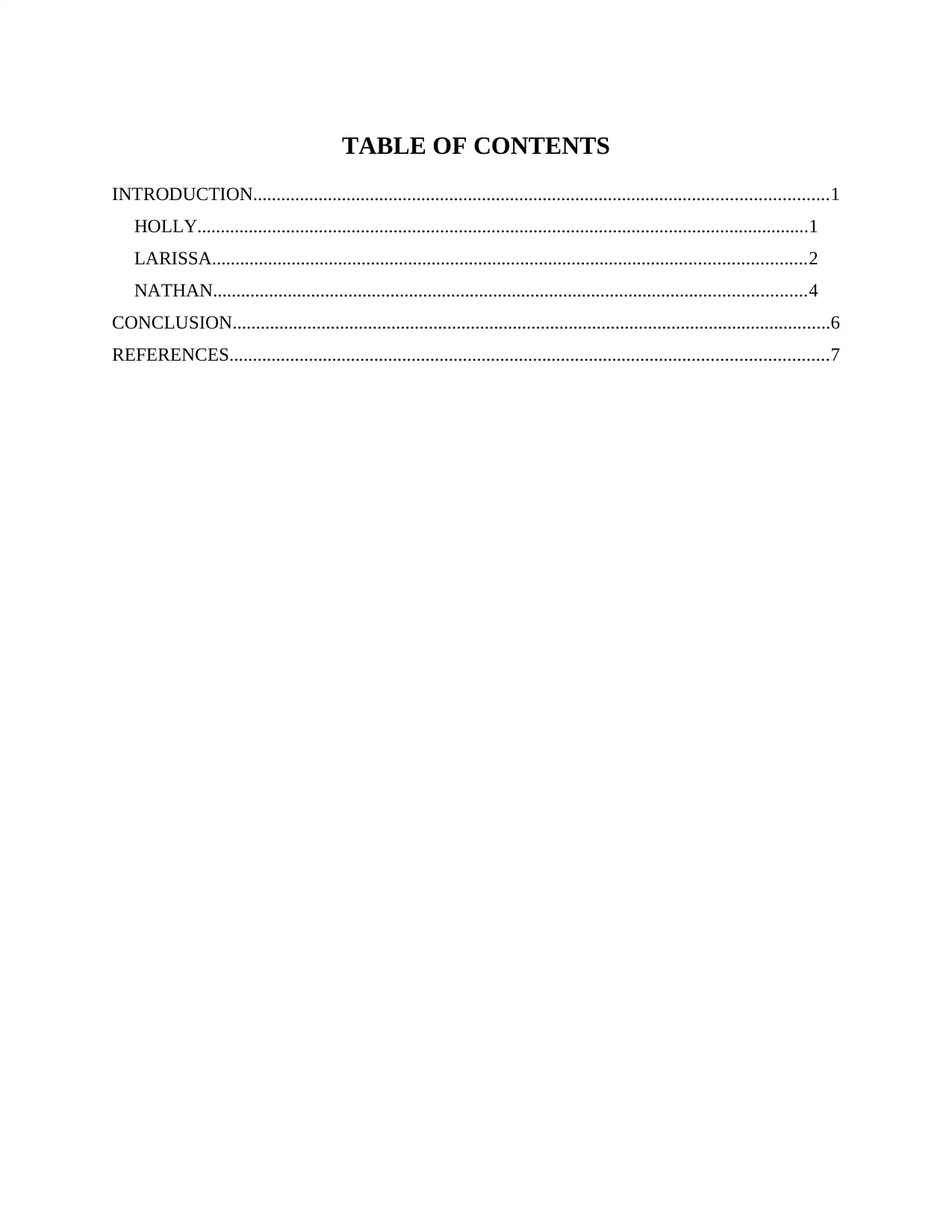
TABLE OF CONTENTS
INTRODUCTION...........................................................................................................................1
HOLLY...................................................................................................................................1
LARISSA...............................................................................................................................2
NATHAN...............................................................................................................................4
CONCLUSION................................................................................................................................6
REFERENCES................................................................................................................................7
INTRODUCTION...........................................................................................................................1
HOLLY...................................................................................................................................1
LARISSA...............................................................................................................................2
NATHAN...............................................................................................................................4
CONCLUSION................................................................................................................................6
REFERENCES................................................................................................................................7
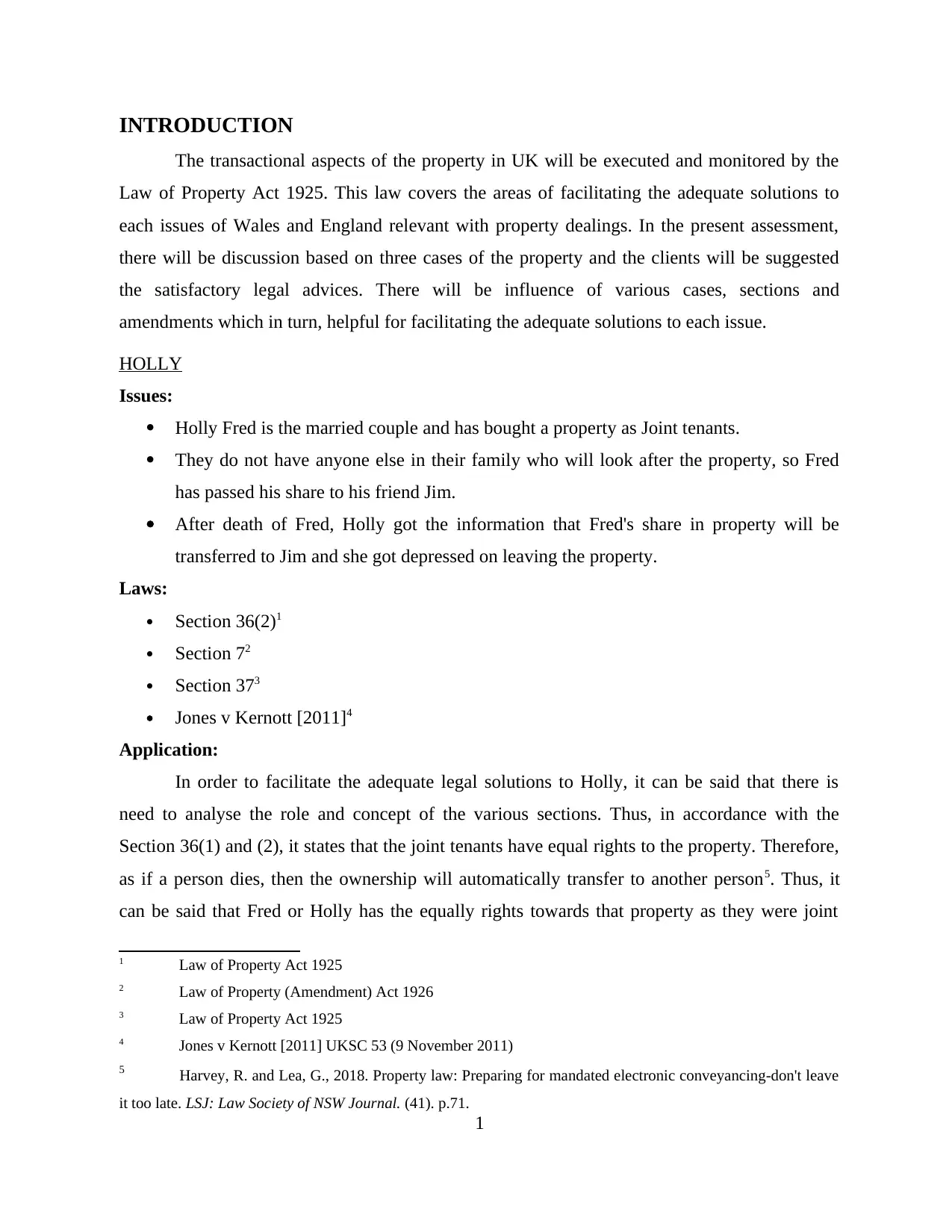
INTRODUCTION
The transactional aspects of the property in UK will be executed and monitored by the
Law of Property Act 1925. This law covers the areas of facilitating the adequate solutions to
each issues of Wales and England relevant with property dealings. In the present assessment,
there will be discussion based on three cases of the property and the clients will be suggested
the satisfactory legal advices. There will be influence of various cases, sections and
amendments which in turn, helpful for facilitating the adequate solutions to each issue.
HOLLY
Issues:
Holly Fred is the married couple and has bought a property as Joint tenants.
They do not have anyone else in their family who will look after the property, so Fred
has passed his share to his friend Jim.
After death of Fred, Holly got the information that Fred's share in property will be
transferred to Jim and she got depressed on leaving the property.
Laws:
Section 36(2)1
Section 72
Section 373
Jones v Kernott [2011]4
Application:
In order to facilitate the adequate legal solutions to Holly, it can be said that there is
need to analyse the role and concept of the various sections. Thus, in accordance with the
Section 36(1) and (2), it states that the joint tenants have equal rights to the property. Therefore,
as if a person dies, then the ownership will automatically transfer to another person5. Thus, it
can be said that Fred or Holly has the equally rights towards that property as they were joint
1 Law of Property Act 1925
2 Law of Property (Amendment) Act 1926
3 Law of Property Act 1925
4 Jones v Kernott [2011] UKSC 53 (9 November 2011)
5 Harvey, R. and Lea, G., 2018. Property law: Preparing for mandated electronic conveyancing-don't leave
it too late. LSJ: Law Society of NSW Journal. (41). p.71.
1
The transactional aspects of the property in UK will be executed and monitored by the
Law of Property Act 1925. This law covers the areas of facilitating the adequate solutions to
each issues of Wales and England relevant with property dealings. In the present assessment,
there will be discussion based on three cases of the property and the clients will be suggested
the satisfactory legal advices. There will be influence of various cases, sections and
amendments which in turn, helpful for facilitating the adequate solutions to each issue.
HOLLY
Issues:
Holly Fred is the married couple and has bought a property as Joint tenants.
They do not have anyone else in their family who will look after the property, so Fred
has passed his share to his friend Jim.
After death of Fred, Holly got the information that Fred's share in property will be
transferred to Jim and she got depressed on leaving the property.
Laws:
Section 36(2)1
Section 72
Section 373
Jones v Kernott [2011]4
Application:
In order to facilitate the adequate legal solutions to Holly, it can be said that there is
need to analyse the role and concept of the various sections. Thus, in accordance with the
Section 36(1) and (2), it states that the joint tenants have equal rights to the property. Therefore,
as if a person dies, then the ownership will automatically transfer to another person5. Thus, it
can be said that Fred or Holly has the equally rights towards that property as they were joint
1 Law of Property Act 1925
2 Law of Property (Amendment) Act 1926
3 Law of Property Act 1925
4 Jones v Kernott [2011] UKSC 53 (9 November 2011)
5 Harvey, R. and Lea, G., 2018. Property law: Preparing for mandated electronic conveyancing-don't leave
it too late. LSJ: Law Society of NSW Journal. (41). p.71.
1
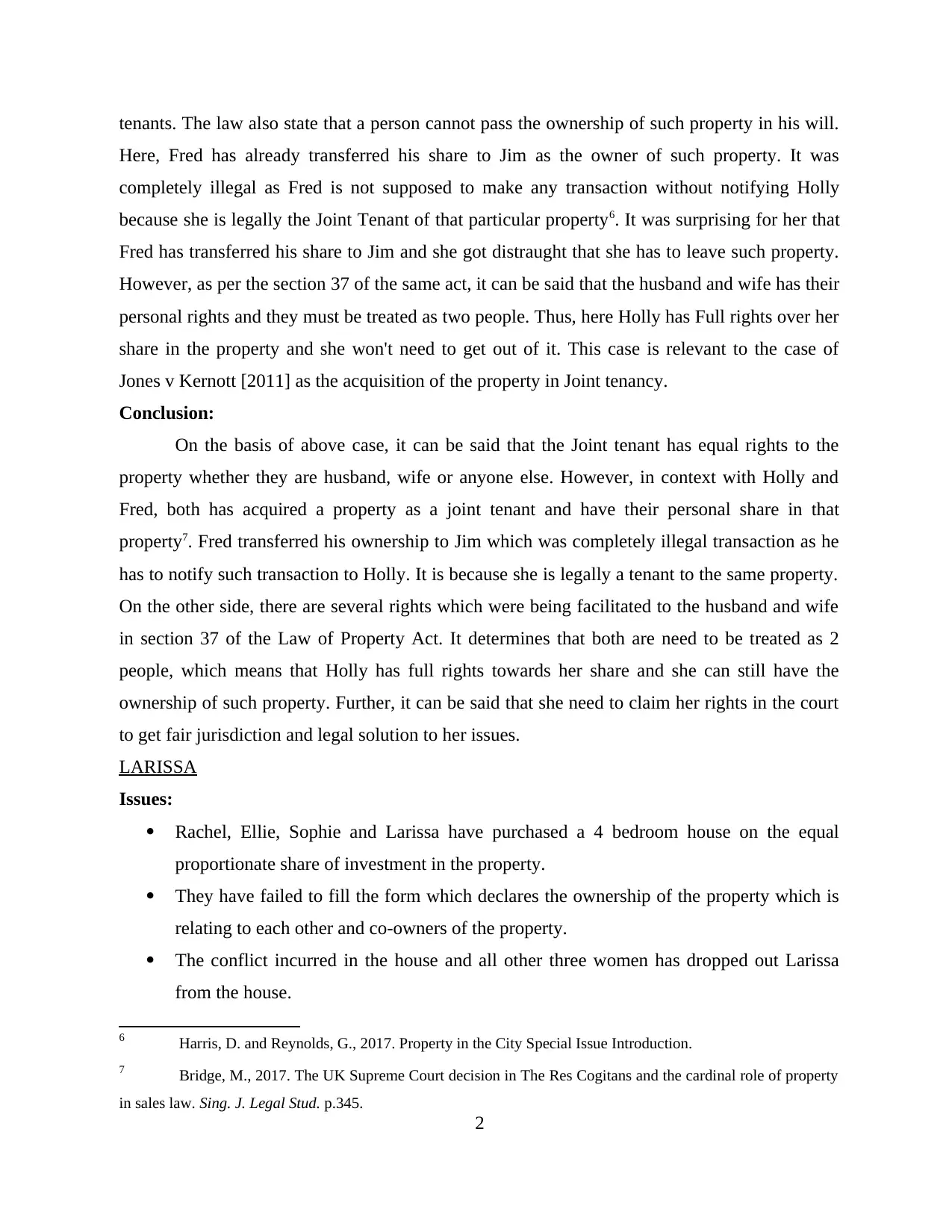
tenants. The law also state that a person cannot pass the ownership of such property in his will.
Here, Fred has already transferred his share to Jim as the owner of such property. It was
completely illegal as Fred is not supposed to make any transaction without notifying Holly
because she is legally the Joint Tenant of that particular property6. It was surprising for her that
Fred has transferred his share to Jim and she got distraught that she has to leave such property.
However, as per the section 37 of the same act, it can be said that the husband and wife has their
personal rights and they must be treated as two people. Thus, here Holly has Full rights over her
share in the property and she won't need to get out of it. This case is relevant to the case of
Jones v Kernott [2011] as the acquisition of the property in Joint tenancy.
Conclusion:
On the basis of above case, it can be said that the Joint tenant has equal rights to the
property whether they are husband, wife or anyone else. However, in context with Holly and
Fred, both has acquired a property as a joint tenant and have their personal share in that
property7. Fred transferred his ownership to Jim which was completely illegal transaction as he
has to notify such transaction to Holly. It is because she is legally a tenant to the same property.
On the other side, there are several rights which were being facilitated to the husband and wife
in section 37 of the Law of Property Act. It determines that both are need to be treated as 2
people, which means that Holly has full rights towards her share and she can still have the
ownership of such property. Further, it can be said that she need to claim her rights in the court
to get fair jurisdiction and legal solution to her issues.
LARISSA
Issues:
Rachel, Ellie, Sophie and Larissa have purchased a 4 bedroom house on the equal
proportionate share of investment in the property.
They have failed to fill the form which declares the ownership of the property which is
relating to each other and co-owners of the property.
The conflict incurred in the house and all other three women has dropped out Larissa
from the house.
6 Harris, D. and Reynolds, G., 2017. Property in the City Special Issue Introduction.
7 Bridge, M., 2017. The UK Supreme Court decision in The Res Cogitans and the cardinal role of property
in sales law. Sing. J. Legal Stud. p.345.
2
Here, Fred has already transferred his share to Jim as the owner of such property. It was
completely illegal as Fred is not supposed to make any transaction without notifying Holly
because she is legally the Joint Tenant of that particular property6. It was surprising for her that
Fred has transferred his share to Jim and she got distraught that she has to leave such property.
However, as per the section 37 of the same act, it can be said that the husband and wife has their
personal rights and they must be treated as two people. Thus, here Holly has Full rights over her
share in the property and she won't need to get out of it. This case is relevant to the case of
Jones v Kernott [2011] as the acquisition of the property in Joint tenancy.
Conclusion:
On the basis of above case, it can be said that the Joint tenant has equal rights to the
property whether they are husband, wife or anyone else. However, in context with Holly and
Fred, both has acquired a property as a joint tenant and have their personal share in that
property7. Fred transferred his ownership to Jim which was completely illegal transaction as he
has to notify such transaction to Holly. It is because she is legally a tenant to the same property.
On the other side, there are several rights which were being facilitated to the husband and wife
in section 37 of the Law of Property Act. It determines that both are need to be treated as 2
people, which means that Holly has full rights towards her share and she can still have the
ownership of such property. Further, it can be said that she need to claim her rights in the court
to get fair jurisdiction and legal solution to her issues.
LARISSA
Issues:
Rachel, Ellie, Sophie and Larissa have purchased a 4 bedroom house on the equal
proportionate share of investment in the property.
They have failed to fill the form which declares the ownership of the property which is
relating to each other and co-owners of the property.
The conflict incurred in the house and all other three women has dropped out Larissa
from the house.
6 Harris, D. and Reynolds, G., 2017. Property in the City Special Issue Introduction.
7 Bridge, M., 2017. The UK Supreme Court decision in The Res Cogitans and the cardinal role of property
in sales law. Sing. J. Legal Stud. p.345.
2
Secure Best Marks with AI Grader
Need help grading? Try our AI Grader for instant feedback on your assignments.
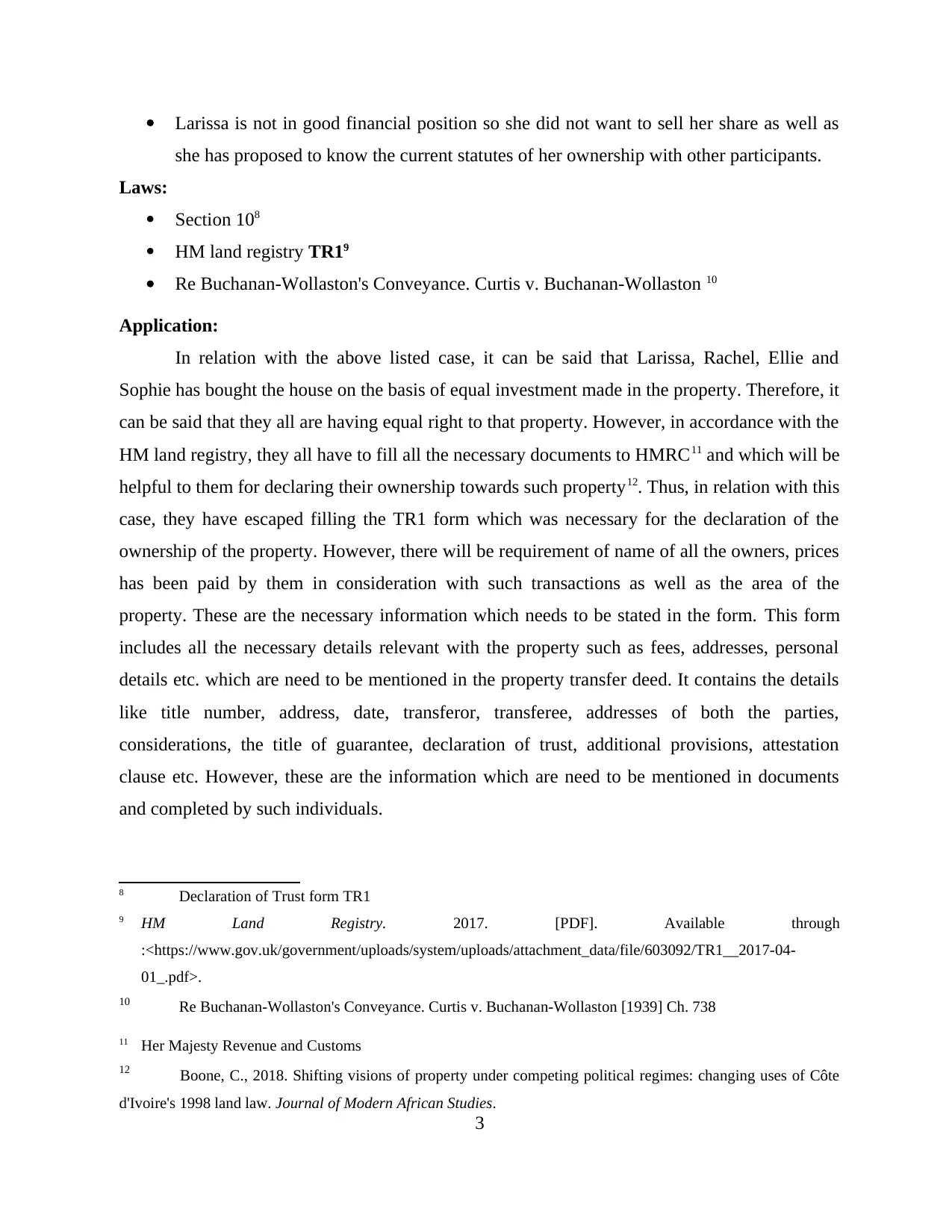
Larissa is not in good financial position so she did not want to sell her share as well as
she has proposed to know the current statutes of her ownership with other participants.
Laws:
Section 108
HM land registry TR19
Re Buchanan-Wollaston's Conveyance. Curtis v. Buchanan-Wollaston 10
Application:
In relation with the above listed case, it can be said that Larissa, Rachel, Ellie and
Sophie has bought the house on the basis of equal investment made in the property. Therefore, it
can be said that they all are having equal right to that property. However, in accordance with the
HM land registry, they all have to fill all the necessary documents to HMRC11 and which will be
helpful to them for declaring their ownership towards such property12. Thus, in relation with this
case, they have escaped filling the TR1 form which was necessary for the declaration of the
ownership of the property. However, there will be requirement of name of all the owners, prices
has been paid by them in consideration with such transactions as well as the area of the
property. These are the necessary information which needs to be stated in the form. This form
includes all the necessary details relevant with the property such as fees, addresses, personal
details etc. which are need to be mentioned in the property transfer deed. It contains the details
like title number, address, date, transferor, transferee, addresses of both the parties,
considerations, the title of guarantee, declaration of trust, additional provisions, attestation
clause etc. However, these are the information which are need to be mentioned in documents
and completed by such individuals.
8 Declaration of Trust form TR1
9 HM Land Registry. 2017. [PDF]. Available through
:<https://www.gov.uk/government/uploads/system/uploads/attachment_data/file/603092/TR1__2017-04-
01_.pdf>.
10 Re Buchanan-Wollaston's Conveyance. Curtis v. Buchanan-Wollaston [1939] Ch. 738
11 Her Majesty Revenue and Customs
12 Boone, C., 2018. Shifting visions of property under competing political regimes: changing uses of Côte
d'Ivoire's 1998 land law. Journal of Modern African Studies.
3
she has proposed to know the current statutes of her ownership with other participants.
Laws:
Section 108
HM land registry TR19
Re Buchanan-Wollaston's Conveyance. Curtis v. Buchanan-Wollaston 10
Application:
In relation with the above listed case, it can be said that Larissa, Rachel, Ellie and
Sophie has bought the house on the basis of equal investment made in the property. Therefore, it
can be said that they all are having equal right to that property. However, in accordance with the
HM land registry, they all have to fill all the necessary documents to HMRC11 and which will be
helpful to them for declaring their ownership towards such property12. Thus, in relation with this
case, they have escaped filling the TR1 form which was necessary for the declaration of the
ownership of the property. However, there will be requirement of name of all the owners, prices
has been paid by them in consideration with such transactions as well as the area of the
property. These are the necessary information which needs to be stated in the form. This form
includes all the necessary details relevant with the property such as fees, addresses, personal
details etc. which are need to be mentioned in the property transfer deed. It contains the details
like title number, address, date, transferor, transferee, addresses of both the parties,
considerations, the title of guarantee, declaration of trust, additional provisions, attestation
clause etc. However, these are the information which are need to be mentioned in documents
and completed by such individuals.
8 Declaration of Trust form TR1
9 HM Land Registry. 2017. [PDF]. Available through
:<https://www.gov.uk/government/uploads/system/uploads/attachment_data/file/603092/TR1__2017-04-
01_.pdf>.
10 Re Buchanan-Wollaston's Conveyance. Curtis v. Buchanan-Wollaston [1939] Ch. 738
11 Her Majesty Revenue and Customs
12 Boone, C., 2018. Shifting visions of property under competing political regimes: changing uses of Côte
d'Ivoire's 1998 land law. Journal of Modern African Studies.
3
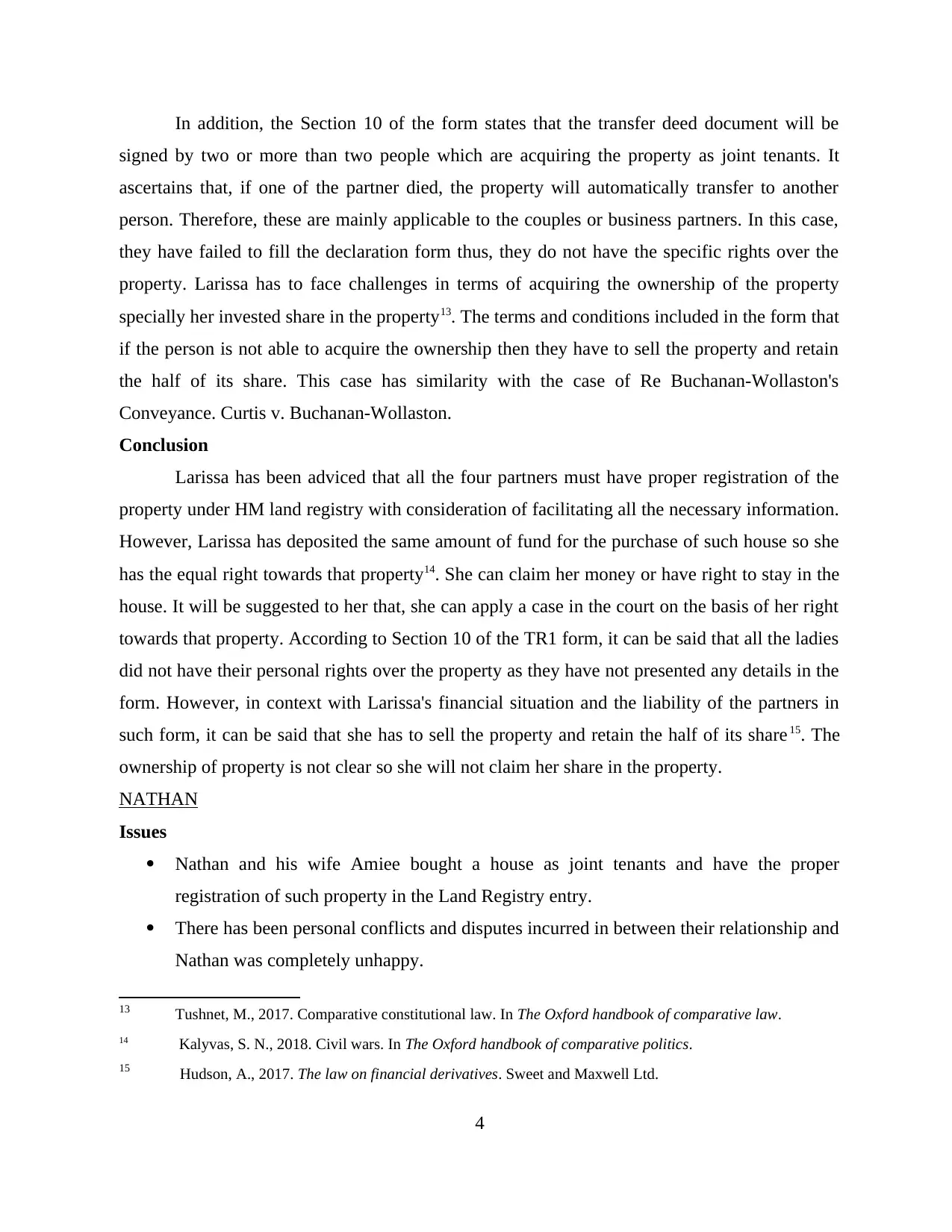
In addition, the Section 10 of the form states that the transfer deed document will be
signed by two or more than two people which are acquiring the property as joint tenants. It
ascertains that, if one of the partner died, the property will automatically transfer to another
person. Therefore, these are mainly applicable to the couples or business partners. In this case,
they have failed to fill the declaration form thus, they do not have the specific rights over the
property. Larissa has to face challenges in terms of acquiring the ownership of the property
specially her invested share in the property13. The terms and conditions included in the form that
if the person is not able to acquire the ownership then they have to sell the property and retain
the half of its share. This case has similarity with the case of Re Buchanan-Wollaston's
Conveyance. Curtis v. Buchanan-Wollaston.
Conclusion
Larissa has been adviced that all the four partners must have proper registration of the
property under HM land registry with consideration of facilitating all the necessary information.
However, Larissa has deposited the same amount of fund for the purchase of such house so she
has the equal right towards that property14. She can claim her money or have right to stay in the
house. It will be suggested to her that, she can apply a case in the court on the basis of her right
towards that property. According to Section 10 of the TR1 form, it can be said that all the ladies
did not have their personal rights over the property as they have not presented any details in the
form. However, in context with Larissa's financial situation and the liability of the partners in
such form, it can be said that she has to sell the property and retain the half of its share 15. The
ownership of property is not clear so she will not claim her share in the property.
NATHAN
Issues
Nathan and his wife Amiee bought a house as joint tenants and have the proper
registration of such property in the Land Registry entry.
There has been personal conflicts and disputes incurred in between their relationship and
Nathan was completely unhappy.
13 Tushnet, M., 2017. Comparative constitutional law. In The Oxford handbook of comparative law.
14 Kalyvas, S. N., 2018. Civil wars. In The Oxford handbook of comparative politics.
15 Hudson, A., 2017. The law on financial derivatives. Sweet and Maxwell Ltd.
4
signed by two or more than two people which are acquiring the property as joint tenants. It
ascertains that, if one of the partner died, the property will automatically transfer to another
person. Therefore, these are mainly applicable to the couples or business partners. In this case,
they have failed to fill the declaration form thus, they do not have the specific rights over the
property. Larissa has to face challenges in terms of acquiring the ownership of the property
specially her invested share in the property13. The terms and conditions included in the form that
if the person is not able to acquire the ownership then they have to sell the property and retain
the half of its share. This case has similarity with the case of Re Buchanan-Wollaston's
Conveyance. Curtis v. Buchanan-Wollaston.
Conclusion
Larissa has been adviced that all the four partners must have proper registration of the
property under HM land registry with consideration of facilitating all the necessary information.
However, Larissa has deposited the same amount of fund for the purchase of such house so she
has the equal right towards that property14. She can claim her money or have right to stay in the
house. It will be suggested to her that, she can apply a case in the court on the basis of her right
towards that property. According to Section 10 of the TR1 form, it can be said that all the ladies
did not have their personal rights over the property as they have not presented any details in the
form. However, in context with Larissa's financial situation and the liability of the partners in
such form, it can be said that she has to sell the property and retain the half of its share 15. The
ownership of property is not clear so she will not claim her share in the property.
NATHAN
Issues
Nathan and his wife Amiee bought a house as joint tenants and have the proper
registration of such property in the Land Registry entry.
There has been personal conflicts and disputes incurred in between their relationship and
Nathan was completely unhappy.
13 Tushnet, M., 2017. Comparative constitutional law. In The Oxford handbook of comparative law.
14 Kalyvas, S. N., 2018. Civil wars. In The Oxford handbook of comparative politics.
15 Hudson, A., 2017. The law on financial derivatives. Sweet and Maxwell Ltd.
4

Client wishes to take divorce from his wife as well as sever the joint tenancy so he has
drafted a written letter about leaving the joint tenancy and placed it into the drawer as
Aimee was on business trip.
Aimee was died while travelling back to home, in air plane crash, Nathan was sad and
regret his intention over sever of the joint tenancy.
Laws:
Section 36(2)16
Section 19917
Quigley v Masterson18
Application
In accordance with the section 36(2) of the act, it can be said that if a person wanted to
severe the joint tenancy agreement and removed his interest in the property which will be a
legal estate. It will only be succeed as if all the person and parties are aware of such changes
and agreed upon sever of the property. In accordance with section 199 of the same act, there are
several restrictions over such transactions19. A partner is drafting the sever document for
breaching the joint tenancy which must be in knowledge and consideration of the other person.
Therefore, Nathan has drafted the sever document to unhappy relationship which was in the
absence of Aimee so it will not be considered as legal estate. Aimee did not reach home and
read that document so she was unaware with such circumstances. On the other side, the
conditions which are mentioned in the Joint tenancy agreement lies that if one partner dies, then
the ownership of the property will automatically transfer to another person. Thus, in this case,
Aimee died due to plane crash; then her share will automatically transfer to Nathan without any
legal obligations or restrictions. However, this case has some similarity with the case of Quigley
v Masterson on the basis of severing the joint tenancy agreement20.
Conclusion
16 Law of property act 1925
17 Law of property act 1925
18 Quigley v Masterson [2011] EWHC 2529 (Ch)
19 Sheppard, A., Peel, D., Ritchie, H. and Berry, S., 2017. The Essential Guide to Planning Law: Decision-
Making and Practice in the UK. Policy Press.
5
drafted a written letter about leaving the joint tenancy and placed it into the drawer as
Aimee was on business trip.
Aimee was died while travelling back to home, in air plane crash, Nathan was sad and
regret his intention over sever of the joint tenancy.
Laws:
Section 36(2)16
Section 19917
Quigley v Masterson18
Application
In accordance with the section 36(2) of the act, it can be said that if a person wanted to
severe the joint tenancy agreement and removed his interest in the property which will be a
legal estate. It will only be succeed as if all the person and parties are aware of such changes
and agreed upon sever of the property. In accordance with section 199 of the same act, there are
several restrictions over such transactions19. A partner is drafting the sever document for
breaching the joint tenancy which must be in knowledge and consideration of the other person.
Therefore, Nathan has drafted the sever document to unhappy relationship which was in the
absence of Aimee so it will not be considered as legal estate. Aimee did not reach home and
read that document so she was unaware with such circumstances. On the other side, the
conditions which are mentioned in the Joint tenancy agreement lies that if one partner dies, then
the ownership of the property will automatically transfer to another person. Thus, in this case,
Aimee died due to plane crash; then her share will automatically transfer to Nathan without any
legal obligations or restrictions. However, this case has some similarity with the case of Quigley
v Masterson on the basis of severing the joint tenancy agreement20.
Conclusion
16 Law of property act 1925
17 Law of property act 1925
18 Quigley v Masterson [2011] EWHC 2529 (Ch)
19 Sheppard, A., Peel, D., Ritchie, H. and Berry, S., 2017. The Essential Guide to Planning Law: Decision-
Making and Practice in the UK. Policy Press.
5
Paraphrase This Document
Need a fresh take? Get an instant paraphrase of this document with our AI Paraphraser
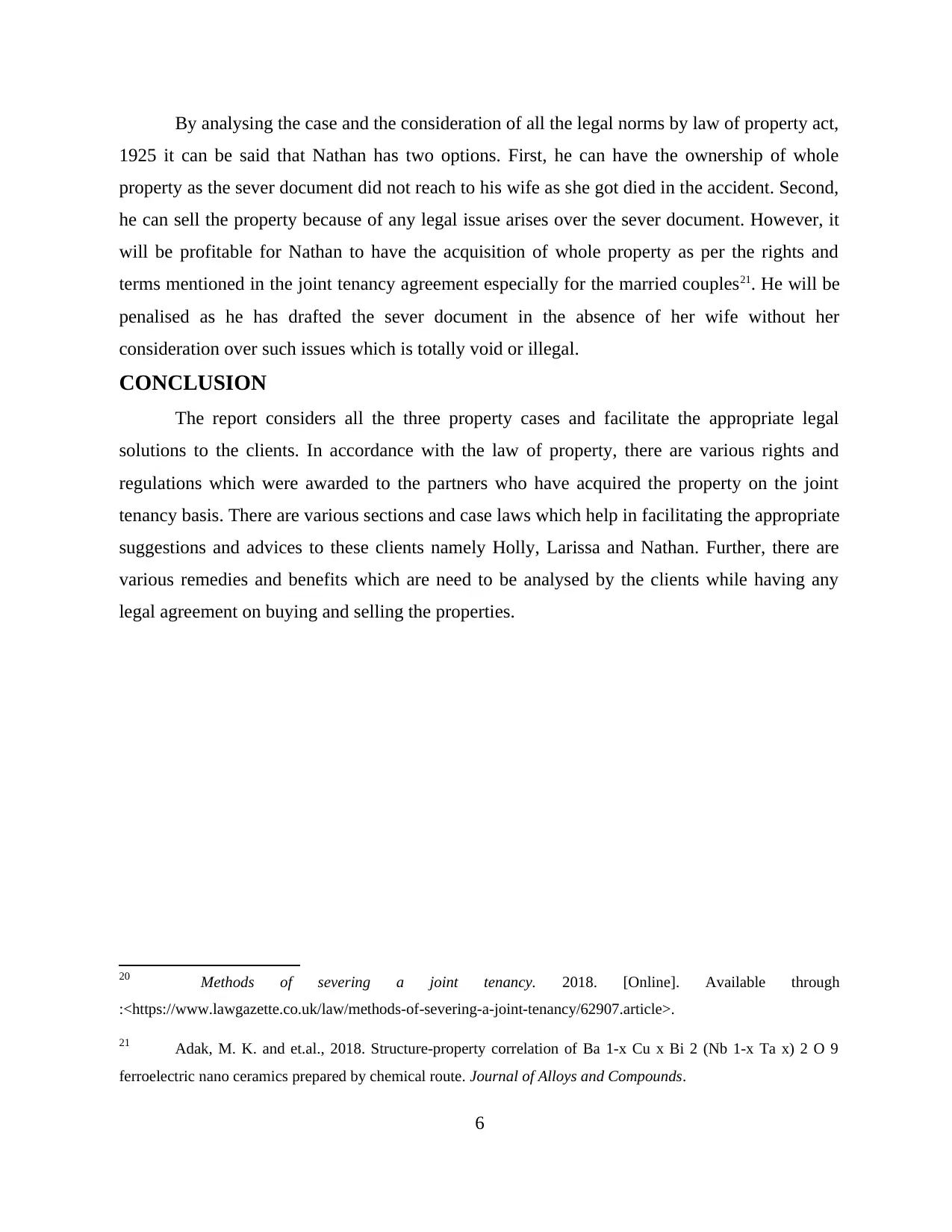
By analysing the case and the consideration of all the legal norms by law of property act,
1925 it can be said that Nathan has two options. First, he can have the ownership of whole
property as the sever document did not reach to his wife as she got died in the accident. Second,
he can sell the property because of any legal issue arises over the sever document. However, it
will be profitable for Nathan to have the acquisition of whole property as per the rights and
terms mentioned in the joint tenancy agreement especially for the married couples21. He will be
penalised as he has drafted the sever document in the absence of her wife without her
consideration over such issues which is totally void or illegal.
CONCLUSION
The report considers all the three property cases and facilitate the appropriate legal
solutions to the clients. In accordance with the law of property, there are various rights and
regulations which were awarded to the partners who have acquired the property on the joint
tenancy basis. There are various sections and case laws which help in facilitating the appropriate
suggestions and advices to these clients namely Holly, Larissa and Nathan. Further, there are
various remedies and benefits which are need to be analysed by the clients while having any
legal agreement on buying and selling the properties.
20 Methods of severing a joint tenancy. 2018. [Online]. Available through
:<https://www.lawgazette.co.uk/law/methods-of-severing-a-joint-tenancy/62907.article>.
21 Adak, M. K. and et.al., 2018. Structure-property correlation of Ba 1-x Cu x Bi 2 (Nb 1-x Ta x) 2 O 9
ferroelectric nano ceramics prepared by chemical route. Journal of Alloys and Compounds.
6
1925 it can be said that Nathan has two options. First, he can have the ownership of whole
property as the sever document did not reach to his wife as she got died in the accident. Second,
he can sell the property because of any legal issue arises over the sever document. However, it
will be profitable for Nathan to have the acquisition of whole property as per the rights and
terms mentioned in the joint tenancy agreement especially for the married couples21. He will be
penalised as he has drafted the sever document in the absence of her wife without her
consideration over such issues which is totally void or illegal.
CONCLUSION
The report considers all the three property cases and facilitate the appropriate legal
solutions to the clients. In accordance with the law of property, there are various rights and
regulations which were awarded to the partners who have acquired the property on the joint
tenancy basis. There are various sections and case laws which help in facilitating the appropriate
suggestions and advices to these clients namely Holly, Larissa and Nathan. Further, there are
various remedies and benefits which are need to be analysed by the clients while having any
legal agreement on buying and selling the properties.
20 Methods of severing a joint tenancy. 2018. [Online]. Available through
:<https://www.lawgazette.co.uk/law/methods-of-severing-a-joint-tenancy/62907.article>.
21 Adak, M. K. and et.al., 2018. Structure-property correlation of Ba 1-x Cu x Bi 2 (Nb 1-x Ta x) 2 O 9
ferroelectric nano ceramics prepared by chemical route. Journal of Alloys and Compounds.
6
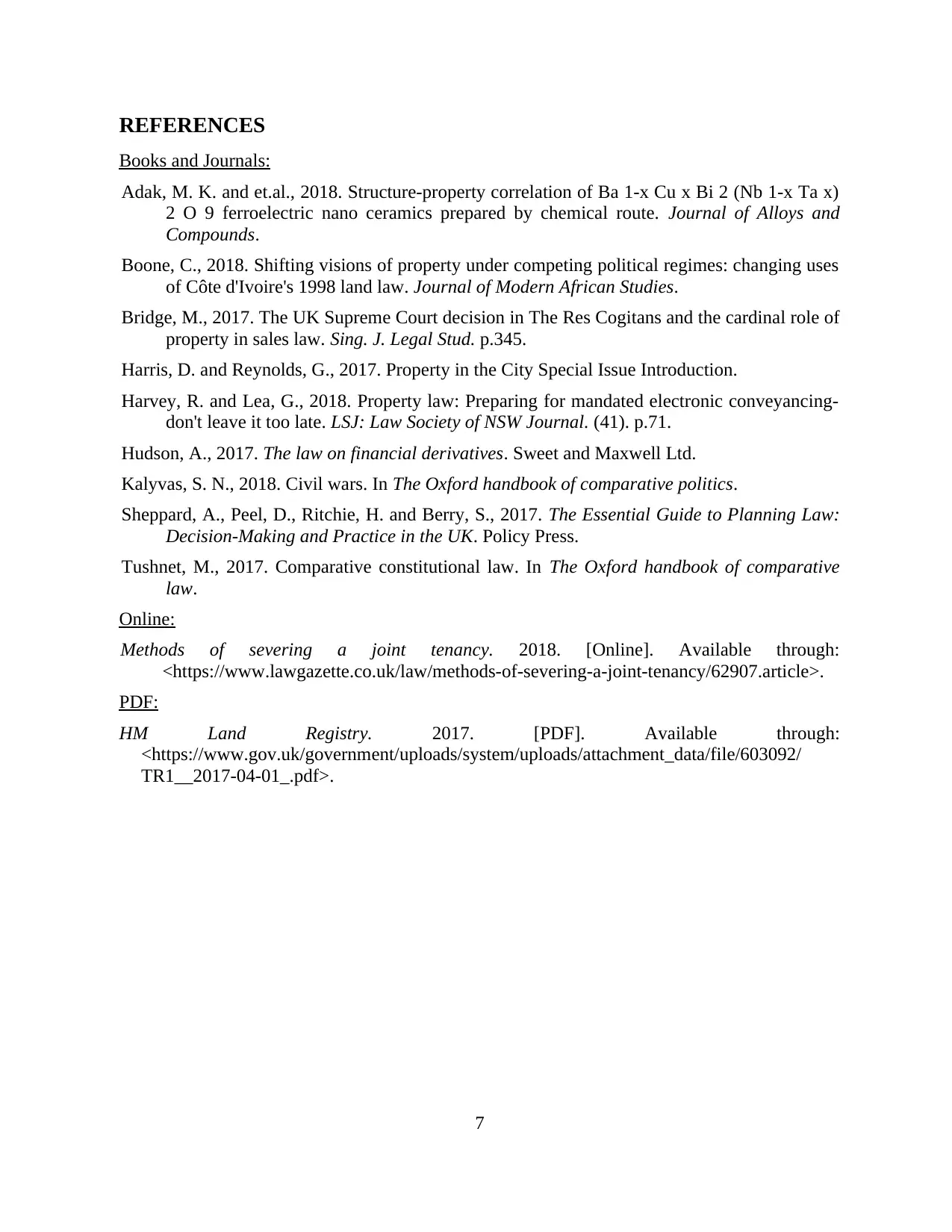
REFERENCES
Books and Journals:
Adak, M. K. and et.al., 2018. Structure-property correlation of Ba 1-x Cu x Bi 2 (Nb 1-x Ta x)
2 O 9 ferroelectric nano ceramics prepared by chemical route. Journal of Alloys and
Compounds.
Boone, C., 2018. Shifting visions of property under competing political regimes: changing uses
of Côte d'Ivoire's 1998 land law. Journal of Modern African Studies.
Bridge, M., 2017. The UK Supreme Court decision in The Res Cogitans and the cardinal role of
property in sales law. Sing. J. Legal Stud. p.345.
Harris, D. and Reynolds, G., 2017. Property in the City Special Issue Introduction.
Harvey, R. and Lea, G., 2018. Property law: Preparing for mandated electronic conveyancing-
don't leave it too late. LSJ: Law Society of NSW Journal. (41). p.71.
Hudson, A., 2017. The law on financial derivatives. Sweet and Maxwell Ltd.
Kalyvas, S. N., 2018. Civil wars. In The Oxford handbook of comparative politics.
Sheppard, A., Peel, D., Ritchie, H. and Berry, S., 2017. The Essential Guide to Planning Law:
Decision-Making and Practice in the UK. Policy Press.
Tushnet, M., 2017. Comparative constitutional law. In The Oxford handbook of comparative
law.
Online:
Methods of severing a joint tenancy. 2018. [Online]. Available through:
<https://www.lawgazette.co.uk/law/methods-of-severing-a-joint-tenancy/62907.article>.
PDF:
HM Land Registry. 2017. [PDF]. Available through:
<https://www.gov.uk/government/uploads/system/uploads/attachment_data/file/603092/
TR1__2017-04-01_.pdf>.
7
Books and Journals:
Adak, M. K. and et.al., 2018. Structure-property correlation of Ba 1-x Cu x Bi 2 (Nb 1-x Ta x)
2 O 9 ferroelectric nano ceramics prepared by chemical route. Journal of Alloys and
Compounds.
Boone, C., 2018. Shifting visions of property under competing political regimes: changing uses
of Côte d'Ivoire's 1998 land law. Journal of Modern African Studies.
Bridge, M., 2017. The UK Supreme Court decision in The Res Cogitans and the cardinal role of
property in sales law. Sing. J. Legal Stud. p.345.
Harris, D. and Reynolds, G., 2017. Property in the City Special Issue Introduction.
Harvey, R. and Lea, G., 2018. Property law: Preparing for mandated electronic conveyancing-
don't leave it too late. LSJ: Law Society of NSW Journal. (41). p.71.
Hudson, A., 2017. The law on financial derivatives. Sweet and Maxwell Ltd.
Kalyvas, S. N., 2018. Civil wars. In The Oxford handbook of comparative politics.
Sheppard, A., Peel, D., Ritchie, H. and Berry, S., 2017. The Essential Guide to Planning Law:
Decision-Making and Practice in the UK. Policy Press.
Tushnet, M., 2017. Comparative constitutional law. In The Oxford handbook of comparative
law.
Online:
Methods of severing a joint tenancy. 2018. [Online]. Available through:
<https://www.lawgazette.co.uk/law/methods-of-severing-a-joint-tenancy/62907.article>.
PDF:
HM Land Registry. 2017. [PDF]. Available through:
<https://www.gov.uk/government/uploads/system/uploads/attachment_data/file/603092/
TR1__2017-04-01_.pdf>.
7
1 out of 9
Related Documents
Your All-in-One AI-Powered Toolkit for Academic Success.
+13062052269
info@desklib.com
Available 24*7 on WhatsApp / Email
![[object Object]](/_next/static/media/star-bottom.7253800d.svg)
Unlock your academic potential
© 2024 | Zucol Services PVT LTD | All rights reserved.





